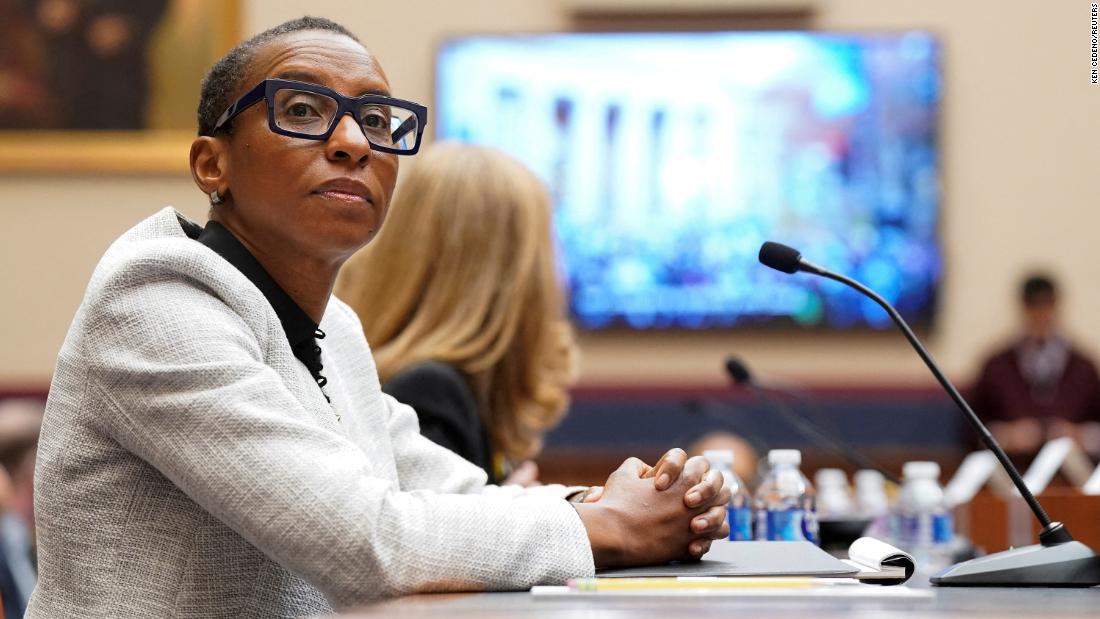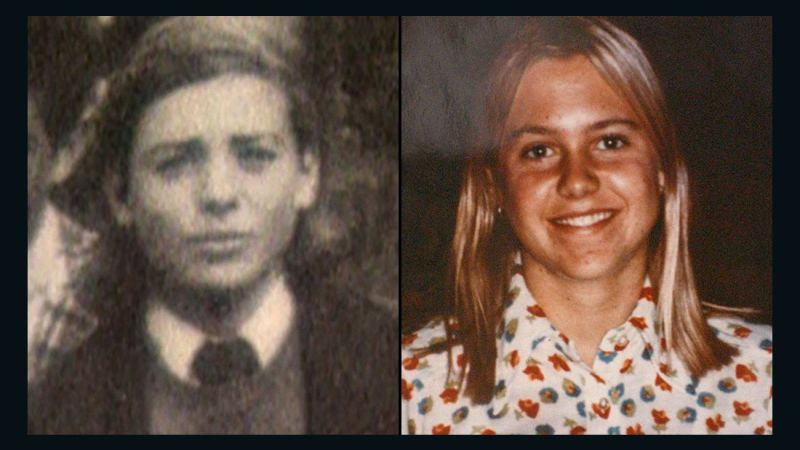Author: CNN
Claudine Gay resigns the presidency of Harvard University amid plagiarism allegations
After months of scrutiny, Harvard President Claudine Gay announced her resignation Tuesday, making hers the shortest term in the university’s history.
Her resignation comes less than a month after she and other leaders of prestigious universities testified before Congress about antisemitism on campus in the wake of the Israel-Hamas war. Critics attacked Gay and the other presidents for their statements on free speech and antisemitism, which snowballed into further scrutiny of Gay and allegations of plagiarism in her past.
Here’s what we know about the months preceding Gay’s resignation:
October 7: Harvard student group blames Israel for Hamas attack — A coalition of student groups at Harvard released a statement blaming Israel for the violence shortly after Hamas launched a devastating attack on Israel. The letter linked the attacks to the Israeli occupation of the West Bank and Gaza and called on Harvard to “take action to stop the ongoing annihilation of Palestinians.”
October 10: Gay condemns Hamas — Gay released a statement condemning the “terrorist atrocities perpetrated by Hamas” and affirming that “no student group — not even 30 student groups — speaks for Harvard University or its leadership.” Several major donors who support Israel cut ties with the university.
November 28: US Department of Education opens investigation — The Department of Education opened an investigation into Harvard “for discrimination involving shared ancestry,” an umbrella term that encompasses both antisemitism and Islamophobia.
December 5: Gay testifies before Congress — Gay and the presidents of the University of Pennsylvania and the Massachusetts Institute of Technology were called to testify before Congress about disciplinary actions taken in the face of antisemitism.
Republican Rep. Elise Stefanik of New York asked Gay if Harvard would take disciplinary action against students or applicants who say “from the river to the sea” or “intifada,” the Arabic word for “uprising.”
Gay said that while she did see that speech as “abhorrent” and “at odds with the value of Harvard,” the university still embraces “a commitment to free expression even of views that are objectionable, offensive, hateful.”
December 9: Plagiarism allegations — As calls continued for Gay to resign after her testimony, Bill Ackman, a billionaire hedge fund CEO and vocal supporter of Israel, posted claims that Gay had plagiarized some of her academic work on social media.
December 15: Gay corrects two academic articles — Gay requested corrections to two scholarly articles published in 2001 and 2017 following allegations of plagiarism. Harvard commissioned an independent review of Gay’s writings following the accusations, which revealed inadequate citations in a few instances but “no violation of Harvard’s standards for research misconduct.”
December 21: More corrections are requested — A Harvard spokesperson said the university reviewed more of Gay’s academic work, and the president plans to update her 1997 PhD dissertation to correct additional instances of “inadequate citation.”
January 2: Gay resigns — Gay announced her resignation just six months after taking office, saying in her resignation letter that it is “frightening to be subjected to personal attacks and threats fueled by racial animus.” Gay said in her letter she would return to a faculty position.
Read the full timeline of the months leading up to Claudine Gay’s resignation.
Michael Skakel Fast Facts
CNN
—
Here’s a look at the life of Michael Skakel, the nephew of Ethel Kennedy. Skakel was convicted in 2002 of the 1975 murder of his neighbor, Martha Moxley. Skakel’s conviction was vacated by the Connecticut Supreme Court in 2018. In October 2020, the Connecticut State’s Attorney announced they will not retry Skakel.
Birth date: September 19, 1960
Birth place: Greenwich, Connecticut
Birth name: Michael Skakel
Father: Rushton Skakel Sr.
Mother: Anne Skakel
Marriage: Margot Sheridan (1991-2001, divorced)
Children: George, 1999
Education: Curry College, Milton, Massachusetts, B.A., 1993
Both Skakel and victim Martha Moxley were 15 years old at the time, and lived near each other in Greenwich, Connecticut.
His older brother, Tommy, and their live-in tutor, Kenneth Littleton, were also suspects.
Prosecutors claimed Skakel killed Moxley in a jealous rage.
Dominick Dunne’s bestselling 1993 novel “A Season in Purgatory” is based on the case.
October 30, 1975 – Martha Moxley fails to return home after her evening out concludes with a stop at the Skakel home to visit Tommy and Michael Skakel, Kennedy nephews by marriage.
October 31, 1975 – Martha’s body is discovered. She is believed to have been beaten to death with a golf club, which is found near her body. Tommy Skakel is questioned by the police.
1978 – Michael Skakel is charged with drunken driving. To sidestep a prosecution, Skakel family attorneys work out a deal with police: Skakel will go to the Elan School in Poland Spring, Maine, to be treated for alcohol addiction and the state will not pursue the charges.
1994 – Skakel works as an aide to Sen. Edward Kennedy’s reelection campaign.
1998 – Two books based on the crime are published – “Greentown,” by Timothy Dumas, and “Murder in Greenwich,” by Mark Fuhrman.
June 1998 – Superior Court Judge George Thim begins an 18-month one-person grand jury review of information gathered by investigators.
January 19, 2000 – An arrest warrant for an unnamed individual is issued in the Moxley murder. Later the same day, Skakel surrenders to police and is released on $500,000 bond.
June 21, 2000 – At a pre-trial hearing, two of Skakel’s former classmates at the Elan School in Maine testify that he had confessed to them back in the 1970s, “I’m gonna get away with murder. I’m a Kennedy.”
May 7, 2002 – Testimony begins in the case.
June 7, 2002 – Skakel is convicted.
August 29, 2002 – Skakel is sentenced to 20 years to life in prison.
November 24, 2003 – Attorneys file an appeal, seeking to overturn his murder conviction.
January 13, 2006 – The conviction is upheld by the Connecticut Supreme Court.
November 13, 2006 – The US Supreme Court declines to hear Skakel’s appeal, meaning his conviction stands.
April 17, 2007 – Skakel’s petition for a new trial is filed. Former high school classmate Gitano “Tony” Bryant says two of his friends were involved in the murder, not Skakel.
October 25, 2007 – The petition for new trial is denied as the judge finds statements not credible that Bryant and his two friends, all African American, could go unnoticed in the mostly white neighborhood.
November 6, 2007 – Skakel’s lawyers file a writ of habeas corpus and petition for a new trial in federal district court.
September 27, 2010 – Skakel’s lawyers file a new appeal claiming that his trial attorney, Mickey Sherman, was incompetent in that he failed to obtain evidence from prosecuting attorneys pointing to other suspects, and that Sherman’s own financial problems drew his focus away from the case. Sherman had pleaded guilty in June to failing to pay $400,000 in federal income taxes.
February 8, 2011 – Skakel testifies in his appeal hearing, the fourth attempt at overturning his conviction.
March 6, 2012 – His appeal is denied by a three-judge panel of the Connecticut Supreme Court.
October 24, 2012 – Skakel is denied parole by the state parole board in Suffield, Connecticut.
October 23, 2013 – A Connecticut Appellate judge orders a new trial for Skakel, saying defense attorney Mickey Sherman’s representation of Skakel was “constitutionally deficient.”
November 21, 2013 – Skakel is released after his bail is posted. Superior Court Judge Gary White sets several conditions for the bail, including barring Skakel from leaving Connecticut without court approval, ordering him to wear a GPS tracking device and requiring that he report to a bail commissioner.
August 8, 2014 – Prosecutors file an appeal to reinstate Skakel’s conviction of killing Moxley in 1975. If the appeal fails, prosecutors state they will retry Skakel.
December 30, 2016 – The Connecticut Supreme Court reinstates Skakel’s 2002 murder conviction in a 4-3 decision, reversing the appellate court’s order for a new trial in 2013. The final version of the court’s decision is released on May 8, 2017.
January 6, 2017 – Skakel’s attorneys file a motion to reconsider the ruling of the Connecticut Supreme Court and requesting a seven-member court panel hear the motion to ensure a “full and fair determination.” The argument raises an unprecedented issue, as the judge who authored the majority decision retired from the court and cannot participate in any future decisions.
May 4, 2018 – The Connecticut Supreme Court vacates Skakel’s conviction. Prosecutors can choose to retry Skakel, but had no comment immediately following the decision.
August 8, 2018 – Connecticut files a petition with the US Supreme Court to review the decision by Connecticut’s high court to vacate Skakel’s conviction based on inadequate assistance of counsel. Skakel files a brief in response to Connecticut’s petition approximately three months later.
January 7, 2019 – The US Supreme Court denies Connecticut’s petition for review.
July 24, 2020 – Federal Judge Michael Shea rules that Connecticut officials cannot keep judicial records and court proceedings secret for cases involving teenagers charged with major felonies, a ruling that will reopen Skakel’s case to the public if he is retried.
October 30, 2020 – Chief State’s Attorney Richard Colangelo Jr. announces that prosecutors for the state of Connecticut will not retry Skakel for the death of Moxley. Addressing the Stamford Superior Court, Colangelo confirms that after “Looking at the evidence, your honor, looking at the state of the case, it is my belief that the state cannot prove this case beyond a reasonable doubt.”
January 3, 2024 – Skakel files lawsuits against the lead police investigator in the case and the town of Greenwich alleging malicious prosecution, violation of his constitutional rights and other claims.
January 1, 2024 Israel-Hamas war

The Israel Defense Forces (IDF) expects warfare in Gaza to last “throughout” this year as it begins to reduce the number of soldiers in the territory and prepares for a new phase of the conflict, a military spokesman has said.
The 551st and 14th brigades – comprised of reservists – will return to their families and civilian lives this week, the IDF said in a statement Monday.
The 828th brigade, which trains squad commanders, the 261st brigade, which trains army officers, and the 460th brigade, which trains the armored corps, will return to their scheduled training, the IDF said.
In a briefing on Sunday, IDF Spokesperson Rear Admiral Daniel Hagari said the objectives of the war “require prolonged fighting.”
The return of reservists, he added, is aimed at ensuring “planning and preparation for the continuation of 2024… understanding that we will be required for additional tasks and warfare throughout this year.”
Monday’s statement said the move is expected to “significantly alleviate economic burdens” and the troops “to gather strength for upcoming activities in the next year, as the fighting will persist, and their services will still be needed.”
Background: Senior US officials told CNN in early December that they expected the current phase of Israel’s ground operation targeting the southern end of the Strip to last several weeks before it transitions, possibly by January, to a lower-intensity, hyper-localized strategy that narrowly targets specific Hamas militants and leaders.
The Biden administration has warned Israel that it cannot replicate the kind of devastating tactics it used in the north and must do more to limit civilian casualties.
Dolly Parton Fast Facts
CNN
—
Here’s a look at the life of Dolly Parton, the Grammy Award-winning singer, song writer, producer and actress.
Birth date: January 19, 1946
Birth place: Locust Ridge, Sevier County, Tennessee
Birth name: Dolly Rebecca Parton
Father: Robert Lee Parton, farmer
Mother: Avie Lee (Owens) Parton
Marriage: Carl Dean (May 1966-present)
Has received 54 Grammy Award nominations and won ten competitive awards. She has also received the Lifetime Achievement Award.
Nominated for two Academy Awards and one Tony Award. Nominated for five Emmy Awards and won one.
Has sold more than 100 million albums worldwide.
Founder of the Dollywood Foundation, which funds Dolly Parton’s Imagination Library – a program which began in Sevier County, Tennessee, and provides preschool-aged children with a book every month from birth to kindergarten. The program has spread to other parts of the country and internationally.
Was born fourth of 12 children. Six of her siblings worked as professional musicians.
1957 – Records her first song, “Puppy Love,” with Goldband Records.
1959 – First guest appearance on the Grand Ole Opry at the age of 13.
1964 – Moves to Nashville after graduating from high school.
1967 – Joins “The Porter Wagoner Show.”
1967 – First full-length album titled “Hello, I’m Dolly,” is released on Monument Records.
1968 – Wins the Country Music Association award, with Porter Wagoner, for Vocal Group of the Year.
January 4, 1969 – Becomes a member of the Grand Ole Opry.
1971 – “Joshua” becomes Parton’s first solo single to top the US country charts.
April 1974 – Leaves “The Porter Wagoner Show.” Parton writes the song “I Will Always Love You” in honor of her professional break from her duet partner and mentor of seven years.
1975 and 1976 – Receives the Country Music Association award for female vocalist of the year.
1976-1977 – Her syndicated variety show “Dolly!” runs on television.
1978 – Receives the Country Music Association Award for entertainer of the year.
February 15, 1979 – Wins a Grammy for Best Country Vocal Performance, Female, for the song “Here You Come Again.”
1980 – Appears in her first film, “9 to 5,” along with Jane Fonda and Lily Tomlin. Parton wrote the original theme song and was later sued in federal court by a couple claiming the recording was copied from their 1976 song, “Money World.” A jury later found in favor of Parton.
February 24, 1982 – Wins two Grammy Awards for the song “9 to 5”: Best Country Vocal Performance, Female and Best Country Song.
May 3, 1986 – The theme park Dollywood opens in Pigeon Forge, Tennessee.
March 2, 1988 – Wins a Grammy, with Emmylou Harris and Linda Ronstadt, for Best Country Performance by a Duo or Group for the album, “Trio.”
1987-1988 – Her primetime variety show on ABC, “Dolly,” airs for one season.
1988 – Establishes the Dollywood Foundation.
1992 – Whitney Houston releases her version of Parton’s song “I Will Always Love You,” which tops the Billboard Hot 100 for 14 weeks, a record at the time.
1994 – Parton’s autobiography, “Dolly: My Life and Other Unfinished Business,” is published.
1999 – Is inducted into the Country Music Hall of Fame.
February 23, 2000 – Wins a Grammy, with Harris and Ronstadt, for Best Country Collaboration with Vocals for the song “After the Gold Rush.”
February 21, 2001 – Wins a Grammy, with Gary Paczosa and Steve Buckingham, for Best Bluegrass Album for “The Grass is Blue.”
February 27, 2002 – Wins a Grammy for Best Female Country Vocal Performance for the song “Shine.”
May 19, 2001 – Dollywood’s Splash Country waterpark opens in Pigeon Forge, Tennessee.
April 14, 2004 – The US Library of Congress awards Parton the Living Legend medal.
2005 – Named a recipient of the National Medal of Arts.
2006 – Is a Kennedy Center honoree.
February 12, 2012 – Receives a Grammy Lifetime Achievement Award.
December 10, 2015 – NBC airs the movie, “Dolly Parton’s Coat of Many Colors.” It is inspired by Parton’s life and her song “Coat of Many Colors.”
November 2, 2016 – Receives the Willie Nelson Lifetime Achievement Award at the 50th Annual Country Music Awards Show.
November 30, 2016 – NBC airs “Dolly Parton’s Christmas of Many Colors: Circle of Love,” a sequel to the original movie which aired in 2015.
November 30, 2016 – In a video message, Parton announces that she has created the “My People Fund” through her Dollywood Companies and hopes to give each family affected by the Great Smoky Mountain wildfires $1,000 a month for six months to help them get “back on their feet.”
February 15, 2017 – Wins a Grammy with Pentatonix, for Best Country Duo/Group Performance, for a remake of her song “Jolene.”
February 27, 2018 – Parton donates the 100 millionth Imagination Library book to the Library of Congress.
February 10, 2019 – Parton is celebrated in an all-star tribute at the 61st Annual Grammy Awards. She also performs at the event for the first time in 18 years along with Miley Cyrus, Little Big Town, Katy Perry and others.
May 3, 2019 – FBI Director Christopher Wray honors Parton with the 2018 Director’s Community Leadership Award. She is given the award as recognition for her efforts to provide financial support to families affected by wildfires that ravaged parts of eastern Tennessee in 2016.
August 5, 2019 – Nashville Mayor David Briley declares the date Dolly Parton Day.
November 26, 2019 – NBC airs “Dolly Parton: 50 Years at the Opry.” The two-hour special celebrates Parton’s milestone as a member of country music’s most esteemed institution.
January 26, 2020 – Wins a Grammy, with the duo For King & Country, for Best Contemporary Christian Music Performance/Song for “God Only Knows.”
April 1, 2020 – Announces she is making a $1 million donation to Vanderbilt University’s coronavirus research.
November 2020 – Parton learns that after donating $1 million to Vanderbilt University’s COVID-19 Research Fund, her assistance partially funded the Moderna Covid-19 vaccine. Parton’s name appears in the preliminary report on the vaccine among sponsors like the National Institute of Allergy and Infectious Diseases.
March 14, 2021 – Wins a Grammy for Best Contemporary Christian Music Performance/Song for “There Was Jesus.”
August 11, 2021 – Parton and mystery writer James Patterson announce they are co-writing a novel, titled “Run, Rose, Run.” The 448-page book will be accompanied by an album based on its characters and situations. The book is published on March 7, 2022.
April 29, 2022 – In an interview with NPR, Parton says that she’d “accept gracefully” if inducted into the Rock & Roll Hall of Fame, one month after she said she wanted to withdraw her nomination.
May 4, 2022 – It is announced that Parton will be inducted into the Rock & Roll Hall of Fame.
June 15, 2022 – Vanderbilt University Medical Center announces that Parton is donating $1 million to pediatric infectious disease research at Vanderbilt.
November 12, 2022 – Parton receives a $100 million Courage and Civility Award from Jeff Bezos and his longtime partner Lauren Sanchez. The award money can be used as Parton sees fit. Last year, Bezos awarded $100 million each to CNN contributor Van Jones and chef José Andrés.
November 17, 2023 – Parton releases her first rock album, “Rockstar.”
This place was inhabited for centuries — but has only recently had tourists
Editor’s Note: This CNN Travel series is, or was, sponsored by the country it highlights. CNN retains full editorial control over subject matter, reporting and frequency of the articles and videos within the sponsorship, in compliance with our policy.
CNN
—
In one of the most rapidly developing countries in the world, there is a monument carved into sandstone, surrounded by date farms and dusty two-lane roads.
This is Hegra.
Also known as al-Hijr or Mada’in Saleh, Hegra is the crown jewel of Saudi Arabia’s archaeological attractions and was the first place in the country inscribed on the UNESCO World Heritage list.
Built between the first century BCE and the first century CE, this ancient city includes an impressive necropolis, with tombs carved into sandstone set against the sweeping desert landscape of northwestern Saudi Arabia.
Petra, the famous site in Jordan, was the capital of the Nabatean people, while Hegra was the kingdom’s southern outpost until it was abandoned in the 12th century.
But while Petra is one of the seven wonders of the modern world and welcomed more than one million visitors per year before the pandemic, Hegra has only been accessible for most international visitors since 2019, when Saudi Arabia first began issuing tourist visas.
Although Hegra doesn’t yet have the same widespread name recognition, that is changing thanks to AlUla, the nearby oasis town that has developed into an arts, culture and tourism hub and now boasts a small but well connected airport, with regular flights from Jeddah, Riyadh, and Dubai.
Out of history’s shadows
The Nabateans are believed to have traded aromatics, like incense and spices, many of which are used in religious rituals.
Two of those were frankincense and myrrh, which many Westerners will recognize as gifts brought to the infant Jesus in the Christian Bible.
But most of their culture has been lost to history. Now, increased investment in archeology from the Saudi government means that more and more information is coming out of Hegra and other Nabatean sites.
“We’ve all heard of the Assyrians, we’ve all heard of the Mesopotamians,” says Wayne Bowen, professor of history at the University of Central Florida. “But (the Nabateans) stood up to the Romans, they stood up to the Hellenistic Greeks, they had this incredible system of cisterns in the desert, controlled the trade routes. I think they just get absorbed in the story of the growth of the Roman Empire.”

Though the Nabateans didn’t leave much behind in the way of historical documentation, one of their culture’s achievements continues to play a huge role in the region – the Nabatean alphabet laid the foundations of modern Arabic.
Recently, some historians literally put a face to the Nabateans.
In early 2023, they revealed “Hinat,” the reconstructed face of a Nabatean woman whose remains were found in the desert. Now, travelers can see her in the Hegra visitors’ center.
On the sandy ground
Upon arriving at the visitors’ center, guests are welcomed with dates and cups of Saudi coffee, which is very lightly brewed and often mixed with cardamom. It’s poured out of a traditional silver urn with a curved spout.
From there, they can jump into a vintage midcentury-style Land Rover (with or without a roof, depending on the weather) with a guide and set off to explore.
Like many places in this sun-soaked part of the world, AlUla and the surrounding region is best to visit early in the morning or evening. That goes even more so at Hegra, which doesn’t have trees or structures to block out the scorching midday sun.
The Nabateans were a nomadic people, so there’s not much left of their daily lives. What remains, though, are their incredible final resting places.

In total, there are around 115 known and numbered tombs.
The most famous of these is Qasr al-Farid (Arabic for “the lonely castle”) which stands proudly alone, its 72-foot structure dramatically set against an expanse of sand. The contrast makes for an excellent photo backdrop, especially just before sunset as pinkish-orange light sets off the desert tones.
One tomb at a time is open to visitors who want to take a peek inside. These open tombs are rotated through so that no single one gets too much foot traffic.
However, they’re much more intricate and interesting on the outside.
The area around the door frames can show names of the people buried there. Design details give clues about where the residents may have traveled from. Images of phoenixes, eagles, and snakes imply familiarity with cultures as far away as Greece and Egypt.
Expand your search
Many visitors combine their Hegra trip with visits to the smaller nearby historic sites of Dadan and Jabal Ikmah.
In the valley of Jabal Ikmah, which the Saudis refer to as an “open-air library,” you can see a range of carved inscriptions in Aramaic, Dadanitic, Thamudic, Minaic and Nabataean, all of which provide glimmers of insight into the rich history of this region. Translations are shown in Arabic, English, and sometimes French, as French monks were early visitors to the area.
Dadan, meanwhile, was once home to a key pre-Islamic trading city, where spice vendors mingled with religious pilgrims.
Its most notable site is the “Lion Tombs,” a group of mausoleums decorated with – as the name indicates – carvings of lions.

It’s simple to visit all three of these sites in a single day. The easiest way to book is via the website of the area’s official government-run tourism body, Experience AlUla. Travelers in a hurry can book a two-hour tour, but there are also afternoon- and day-long options.
Don’t miss the covered outdoor station near the Hegra visitor’s center, where you can practice using a small chisel to carve your name or initials into pieces of stone.
The amount of effort involved will make you really appreciate how much work the Nabateans put into creating these masterpieces. Miniature versions of Hegra’s most magnificent structures, made by the women who run this workshop, are available for sale as well.
These days, Petra is focused on preservation and combating over-tourism, which gives Hegra the opportunity to grow and attract more visitors.
According to David Graf, professor emeritus of Middle Eastern History at the University of Miami, many of the archaeologists who formerly led excavations at Petra are relocating to Saudi Arabia, which likely means there will be new discoveries in the years to come.
It also means that more people around the world will learn about the Nabateans and their contributions to history.
“The Nabataeans were a very cosmopolitan, sophisticated culture, and I’ve been trying to emphasize that,” says Graf, who continues to publish articles and give talks in his retirement.
“We didn’t know a lot about the Nabataeans. I’ve been on the mission to see that we know more about them. That we see them as not backward and primitive, but really engaged and involved, and dynamic people who were interacting with Rome and the Greek world and other cultures.”
Italy divided over new pineapple pizza
Editor’s Note: Sign up for Unlocking the World, CNN Travel’s weekly newsletter. Get the latest news in aviation, food and drink, where to stay and other travel developments.
CNN
—
Anyone who’s set foot in Italy knows there are unwritten rules that one must abide by – and the most important of all revolve around food. Cappuccino after 11 a.m.? Only for tourists. Spaghetti bolognese? A horrifying thought. Pineapple on your pizza? Heresy – at least, it was until now.
But 2024 might just be the year that pineapple pizza cracks Italy, thanks to Gino Sorbillo, the renowned Naples pizzaiolo (pizza maestro) who has added the dreaded “ananas” to his menu in Via dei Tribunali, the best known pizza street in the world capital of pizza.
Sorbillo’s creation, called “Margherita con Ananas” costs 7 euros ($7.70). But this isn’t your regular Hawaiian: it is a pizza bianca, denuded of its tomato layer, sprinkled with no fewer than three types of cheese, with the pineapple cooked twice for a caramelized feel.
Sorbillo, a third-generation pizzaiolo, told CNN that he created it to “combat food prejudice.”
“Sadly people follow the crowd and condition themselves according to other people’s views, or what they hear,” he said.
“I’ve noticed in the last few years that lots of people were condemning ingredients or ways of preparing food purely because in the past most people didn’t know them, so I wanted to put these disputed ingredients – that are treated like they’re poison – onto a Neapolitan pizza, making them tasty.”
Doing it in his headquarters in the historic center of Naples with its 3,000 years of history – Sorbillo has 21 outlets around the world including in Miami, Tokyo and Ibiza – was also making an important point, he said.
The pineapple is prebaked in the oven and then cooled. Then he adds smoked provola (a local cow milk cheese from Campania), extra virgin olive oil, and fresh basil, before popping the pizza in his woodfired oven.
As it comes out of the oven, he scatters “micro shavings” of two types of smoked cacioricotta cheese around the crust: one from Sardinian goats, and another from buffalos in the nearby Cilento area.
“It makes it really tasty,” he said.
Tasty or not, pineapple on pizza is anathema to most Italians, and his pizza – which he launched on social media this week – hasn’t gone down well with many. It has, Sorbillo said, started “uproar” with insults on social media, and his pizza even being discussed on national TV.
But he says that those who’ve been curious enough to try it have been favorable.
“Before I launched it on social media, I put it on the menu without saying anything for a couple of weeks, and lots of people ordered it, even Neapolitans,” he said.
“But Italy is split in half about it. And not just Italy. There’s a load of arguments that have opened up about it. I think people in general are not curious. They are mistrustful of anything different.”

Barbara Politi, a food journalist who rushed straight to Naples to try it, was positive.
“It’s good, fresh, I’m in favor of it,” she said. “Did you know that pineapple has been part of Europe’s food culture since Christopher Columbus tasted it in Guadeloupe in 1493 and brought it back?
“When Sorbillo launched it, I was curious and looked into how long pineapple had been used in Europe, and I found that it has been part of European [food] culture for a long time. So in reality we’re talking about a question of mentality and of taste habits.
“I liked it, it’s a bit like sushi – at the start you might not love it but then it becomes a fixation.”
For Sorbillo, pineapple on pizza is no different to the more adventurous toppings pizzaioli have been working with in recent years.
“In the last few years people have been using ingredients that five, six years ago were never used. Now we use speck from Alto Adige, mortadella which wasn’t used 10 years ago, chopped pistachios, powdered olives, mozzarella foam, even jams. Why shouldn’t we rediscover pineapple? Pizza has been taking on a new life for the past five or six years.”
He said he thought his pizzaiolo ancestors “would be perplexed” by his pineapple offering, but added, “Things should be tasted first, and then you express your view. In the past, not even ham or arugula went on pizzas, now they’re normal.”

However, one thing he draws the line at is starting with a tomato base.
“That’s another fruit – with two fruits, which both have acidity it wouldn’t be a good product,” he said. “Instead, I put three smoked cheeses on, and it changes the pizza, becomes a different taste.”
He said that the Hawaiian’s history, using tomato, meant that “people condemn it without trying to work on it, as I did.”
“Obviously there are polemics from people who say you shouldn’t use it. But why are you offended? Nobody is forcing you to buy it.
“Pairings are important in food. If you pair ingredients well, the result is good. People who are gastronomically curious are eating it, which means we did well.”
In fact, Sorbillo has already used the criticism to create another controversial pizza.
“When the pineapple pizza came out, someone wrote, ‘Now see if you can do a ketchup one, so I did it,” he said. “And another row started.”
It was no ordinary ketchup, though; instead, he used homemade sauce from red and yellow Italian datterino tomatoes, on a white base with smoked provola. He then filmed himself eating it triumphantly, surrounded by bottles of homemade ketchup, pronouncing it “good.”
“All you need to change is one ingredient, or one preparatory step, and you create a whole new thing,” he said.
“I’m sure that soon pineapple pizza will appear on the menus of other pizzerias in Naples – and not only in Naples.”
January 1, 2024 Japan earthquake

Four bullet trains, whose high-speed journeys were halted when a powerful earthquake struck Japan on Monday, have now resumed service to their destinations, according to Japan’s public broadcaster NHK.
The high-speed trains had been stranded between the central Japanese cities of Toyama and Kanazawa following the 7.5 magnitude tremor.
After being stationary for more than 11 hours, two trains arrived at the Toyama station at 4 a.m. local time on Tuesday (2 p.m. ET on Monday), officials said. Another two trains traveling in the opposite direction arrived at the Kanazawa station in Ishiwaka prefecture.
Nearly 1,400 passengers had been stranded inside the high-speed trains, NHK said, citing Japan Railways West.
The broadcaster said there were no reports of anyone on the trains becoming ill during the wait.
One key number that could spell doom for Democrats in the midterms
myGrilloCOM Video
One key number that could spell doom for Democrats in the midterms
December 31, 2023 Israel-Hamas war

Yemen’s Iran-backed Houthi rebels are stepping up their strikes on ships in the Red Sea, which they say are revenge against Israel for its military campaign in Gaza.
There are fears that the attacks could escalate Israel’s war against Hamas into a wider regional conflict.
The US said Sunday that it has no desire to enter a wider war, but that it will act in its own self-defense, after US Navy helicopters sank three Houthi boats that the US says fired on the aircraft in the Red Sea. The helicopters had been responding to a distress call from the latest commercial vessel to come under Houthi fire.
The attacks have forced some of the world’s biggest shipping and oil companies to suspend transit through one of the world’s most important maritime trade routes, which could potentially cause a shock to the global economy.
Here’s what we know about the Houthis:
Who are the Houthis? The Houthi movement, also known as Ansarallah (Supporters of God), is one side of the Yemeni civil war that has raged for nearly a decade. It emerged in the 1990s, when its leader, Hussein al-Houthi, launched “Believing Youth,” a religious revival movement for a centuries-old subsect of Shia Islam called Zaidism.
His closest followers became known as Houthis.
How did they gain power? Ali Abdullah Saleh, the first president of Yemen after the 1990 unification of North and South Yemen, initially supported the Believing Youth. But as the movement’s popularity grew and anti-government rhetoric sharpened, it became a threat to Saleh. Things came to a head in 2003, when Saleh supported the United States invasion of Iraq, which many Yemenis opposed.
For al-Houthi, the rift was an opportunity. Seizing on the public outrage, he organized mass demonstrations. After months of disorder, Saleh issued a warrant for his arrest.
Al-Houthi was killed in September 2004 by Yemeni forces, but his movement lived on. The Houthi military wing grew as more fighters joined the cause. Emboldened by the early Arab Spring protests in 2011, they took control of the northern province of Saada and called for the end of the Saleh regime.
How powerful are the Houthis? American officials have been tracking iterative improvements in the range, accuracy and lethality of the Houthis’ domestically produced missiles. Initially, home-grown Houthi weapons were largely assembled with Iranian components smuggled into Yemen in pieces, an official familiar with US intelligence told CNN previously.
But they have made modifications that have added up to big overall improvements, the official said. In a novel development, the Houthis have used medium-range ballistic missiles against Israel, firing a salvo of projectiles at Israel’s southern region of Eilat in early December, which Israel said it intercepted.
While the Houthis may not be able to pose a serious threat to Israel, their technology can wreak havoc in the Red Sea. They have used drones and anti-ship missiles to target commercial ships — some of which aren’t believed to be linked to Israel — prompting the USS Carney, a warship in the Red Sea, to respond to distress calls.









